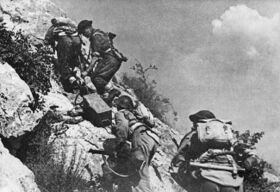Battle of Mushroom Hill
This article is incomplete because it is pending further input from participants, or it is a work-in-progress by one author. Please comment on this article's talk page to share your input, comments and questions. Note: To contribute to this article, you may need to seek help from the author(s) of this page. |
| Battle of Mushroom Hill | |||||||
|---|---|---|---|---|---|---|---|
| Part of the Asianna and the Pacific Campaign of the Second Europan War | |||||||
 Zanarkian troops assaulting Quenminese positions near Mushroom Hill, 17 October 1943 | |||||||
| |||||||
| Belligerents | |||||||
|
Relief Force: (19 October) |
| ||||||
| Commanders and leaders | |||||||
|
Yeoncheon Garrison: Relief Force: (19 October) | |||||||
| Units involved | |||||||
| |||||||
| Casualties and losses | |||||||
|
4,789 wounded or killed 59 tanks 55 guns 35 aircraft |
3,959 wounded or killed 79 tanks 49 guns 49 aircraft | ||||||
The Battle of Mushroom Hill (29 September - 21 October 1943) was an engagement around the nearby town of Yeoncheon and nearby it was a 300m tall hill that was the location of a bloody engagement between ZANAC and Joyonghean forces against a combined Quenminese-Archadian force led by Marshal Hồ Danh Sĩ Quốc. After General Douglas Tecumseh Stilwell's failure to contain Quenminese forces during the Second Battle of Taeju, Ho took the opportunity of pushing his forces against the ZANACs around the Yeoncheon County, seeing an opportunity to destroy the ZANACs and rob the Allied forces of one of their most competent formations.
Following the removal of Concordian and Joyonghean forces near at Taeju, and with Marshal Ho splitting a portion of Joyonghean forces from the main force, General Namgung Wook-yun chose to rendezvous with General Edward Samegawa's forces at the Yeoncheon County. Samegawa had been tasked with guarding the flanks for General Albert Crocker's Operation Sequoia. When the news of Crocker's push being delayed due to the autumn rains, the two generals dug their forces around the country, with their armoured force garrisoned at the town of Yeoncheon. Archadian reconnaissance reported this to Marshal Ho, who didn't want to squander the opportunity of destroying the ZANACs once and for all. In 29 September, the Quenminese threw a massive offensive at the Yeoncheon County. General Ong Thao-Pin's Steel Tiger Divisions were able to force Samegawa's armour into the town of Yeoncheon and its surrounding areas while Samegawa and Namgung were trapped on the hill along with the rest of their forces. Ho forced the Allies to fighting a war of attrition, capitalising on the heavy rains. As a result, Samegawa had limited movements around the county. For the next few days, casualties on the Allies were mounting but the ZANACs and Joyongheans put up a stiff defence line around the hill. While General Simmon Denzel Crocker and the trapped armoured force in the town capitalised on the ruined structures and dug mines and traps for Quenminese and Archadian infantry and tanks. This enabled the Allies to inflict as much damage as possible.
By 9 October, Allied supplies started to get low, as supply by air remained impossible thanks to Quenminese Anti-Air units and aircraft to the point that the defenders had to appropriate captured Imperial equipment. But on the same day, the reversal of fortunes came when Crocker launched a counteroffensive across across the Cheorwon County in order to get 2 of his best divisions into the Yeoncheon region. By 15 October, the two Lucian divisions arrived in the area and began engaging with Quenminese and Archadian forces around the town. It was finally relieved by 18 October and Crocker ordered Allied forces to relieve the defenders at the hill. By 21 October, elements of the 57th Division finally relieved the hill.
In the same battle, Samegawa's group was ambushed by a retreating Quenminese platoon, who thought of the opportunity to capture key Allied commanders. Here, Joyonghean General Namgung Wook-yun was killed as he used his body to shield Samegawa from oncoming bullets, not wanting his lose their key to victory, making Wook-yun as the highest ranking casualty within the Joyonghean Army. His sacrifice proved not to be in vain, as Samegawa continued to lend a hand on battles that Joyonghean forces were involved in until the end of the war.